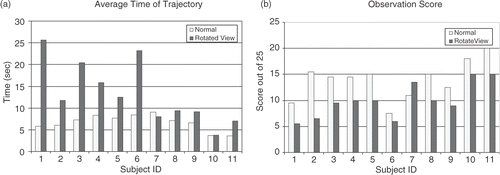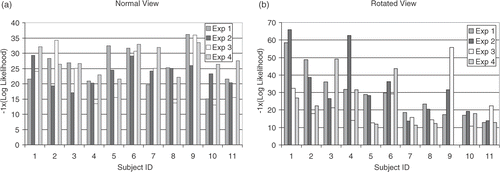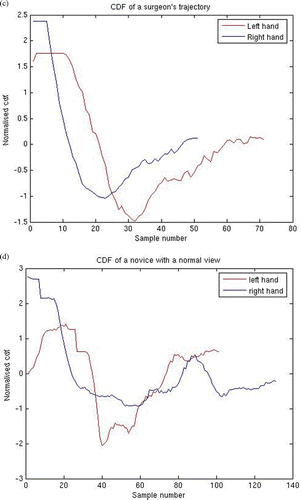Figures & data
Figure 1. Experiment setup showing the arrangement of the IR sensors in relation to the laparoscope tools (a), and the plastic small bowel model with a simulated omental flap with and without the camera view being rotated (b, c). [Color version available online.]
![Figure 1. Experiment setup showing the arrangement of the IR sensors in relation to the laparoscope tools (a), and the plastic small bowel model with a simulated omental flap with and without the camera view being rotated (b, c). [Color version available online.]](/cms/asset/7f1014d3-6e9b-44ca-8ca7-0a84c958dc41/icsu_a_273032_f0001_b.gif)
Figure 2. (a, b): 3D trajectories of surgeon and novice; blue represents the right hand and red the left. (c, d) (on next page): CDF representation of the same trajectories. [Color version available online.]
![Figure 2. (a, b): 3D trajectories of surgeon and novice; blue represents the right hand and red the left. (c, d) (on next page): CDF representation of the same trajectories. [Color version available online.]](/cms/asset/17b2303a-bc01-4e4d-b9a8-6d97c48c09d8/icsu_a_273032_f0002_b.gif)
Table I. Modified version of the Objective Structured Assessment of Technical Skills (OSATS) global rating scale.
Figure 3. (a) Average time for the trajectories of each subject. (b) Modified OSATS score for all subjects involved in the experiments.

Figure 4. (a) Mean CDF trajectory for one of the experiments with standard deviation. Examples of a practicing surgeon's trajectory (in black) and a novice's trajectory (in pink) are shown. (b) The HMM learned curve is shown in green. [Color version available online.]
![Figure 4. (a) Mean CDF trajectory for one of the experiments with standard deviation. Examples of a practicing surgeon's trajectory (in black) and a novice's trajectory (in pink) are shown. (b) The HMM learned curve is shown in green. [Color version available online.]](/cms/asset/67fbb874-2028-4198-83c2-77a3c3c4fe58/icsu_a_273032_f0004_b.gif)
Figure 5. Negative log likelihood of the subject in each experiment belonging to the group (a) in the normal view orientation and (b) in the rotated orientation.

Figure 6. (a) Mean rank of subjects’ likelihood of belonging to the test group. (b) Scatter plot of the rank of likelihood generated by the trained HMM against OSATS score ranking in the rotated tasks.

Figure 7. Means of CDF for all four trajectories with standard deviation. Means of the pre- and post-training data are plotted in black and pink, respectively. [Color version available online.]
![Figure 7. Means of CDF for all four trajectories with standard deviation. Means of the pre- and post-training data are plotted in black and pink, respectively. [Color version available online.]](/cms/asset/c1dabecf-87a5-4a3b-8607-7a905d721e92/icsu_a_273032_f0007_b.gif)
Figure 8. (a) Box plot of the negative log likelihood of subjects’ pre- and post-training data belonging to the test group where the median (line), inter-quartile range (shaded box), range of the data (whiskers), outliers (circles) and extremes (stars) are plotted. [Color version available online.] (b) Likelihood ranks of individual subjects’ trajectories before and after training.
![Figure 8. (a) Box plot of the negative log likelihood of subjects’ pre- and post-training data belonging to the test group where the median (line), inter-quartile range (shaded box), range of the data (whiskers), outliers (circles) and extremes (stars) are plotted. [Color version available online.] (b) Likelihood ranks of individual subjects’ trajectories before and after training.](/cms/asset/62d29435-de2f-41b5-8882-893fcdd2e972/icsu_a_273032_f0008_b.gif)
